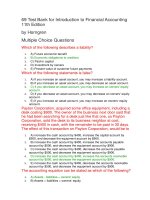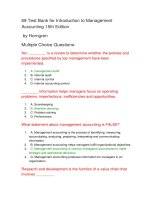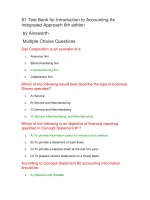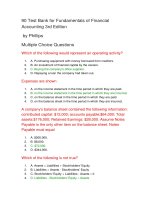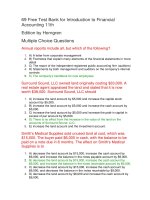119 test bank for introduction to financial accounting 11th edition
Bạn đang xem bản rút gọn của tài liệu. Xem và tải ngay bản đầy đủ của tài liệu tại đây (160.61 KB, 41 trang )
119 Test Bank for Introduction to Financial Accounting
11th Edition
Multiple Choice Questions - Page 1
Iacofano Pizza Place acquired equipment costing $11,000 on account. The
effect of this transaction on Iacofano Pizza Place would be to
1.
A) increase equipment by $11,000 and decrease capital by $11,000.
2.
B) increase equipment by $11,000 and increase capital by $11,000.
3.
C) increase equipment by $11,000 and increase accounts payable by $11,000.
4.
D) increase equipment by $11,000 and decrease accounts payable by $11,000.
5.
E) No transaction is recorded since no cash has been paid.
Income taxes owed to the federal government would be classified as a(n)
1.
A) liability on the balance sheet.
2.
B) asset on the balance sheet.
3.
C) liability on the statement of cash flows.
4.
D) equity on the balance sheet.
5.
E) They would not appear on a financial statement.
Surround Sound, LLC owned land originally costing $33,000. A real estate
agent appraised the land and stated that it is now worth $38,000. Surround
Sound, LLC should
1.
A) increase the land account by $5,000 and increase the capital stock account by
$5,000.
2.
B) increase the land account by $5,000 and increase the cash account by $5,000.
3.
C) increase the land account by $5,000 and increase the paid-in capital in excess of par
account by $5,000.
4.
D) There is no effect from the increase in the value of the land on the accounts of
Surround Sound, LLC.
5.
E) increase the land account and the investment account.
What effect does the purchase of store equipment on account have on the
balance sheet equation?
1.
A) Assets increase and liabilities decrease
2.
B) Assets increase and liabilities increase
3.
C) Assets decrease and liabilities decrease
4.
D) Assets decrease and liabilities increase
5.
E) There is no effect on the accounting equation.
Mexland Company, acquired land costing $25,000. Mexland Company paid
$10,000 in cash and issued a short-term note for the balance. The effect of this
transaction on Mexland Company, would be to
1.
A) increase the land account by $25,000, decrease the cash account by $10,000, and
decrease the balance in the notes payable account by $15,000.
2.
B) increase the land account by $25,000, decrease the cash account by $10,000, and
decrease the balance in the notes receivable account by $15,000.
3.
C) increase the land account by $25,000, decrease the cash account by $10,000, and
increase the balance in the notes receivable account by $15,000.
4.
D) increase the land account by $10,000 and decrease the cash account by $10,000.
5.
E) increase the land account by $25,000, decrease the cash account by $10,000, and
increase the balance in the notes payable account by $15,000.
Payton Corporation, acquired some office equipment, including a desk costing
$900. The owner of the business next door said that he had been searching for
a desk just like that one, so Payton Corporation, sold the desk to its business
neighbor at cost, receiving $400 in cash, with the remainder to be paid in 30
days. The effect of this transaction on Payton Corporation, would be to
1.
A) increase the cash account by $400, increase the capital account by $500, and
decrease the equipment account by $900.
2.
B) increase the cash account by $400, increase the accounts payable account by $500,
and decrease the equipment account by $900.
3.
C) increase the cash account by $400, decrease the accounts payable account by $500,
and decrease the equipment account by $900.
4.
D) increase the cash account by $400, increase the accounts receivable account by
$500, and decrease the equipment account by $900.
5.
E) increase the cash account by $400, decrease the accounts receivable account by
$500, and decrease the equipment account by $900.
The accounting equation can be stated as which of the following?
1.
A) Assets - liabilities = owners' equity
2.
B) Assets + liabilities = owners' equity
3.
C) Liabilities + assets = owners' equity
4.
D) Owners' equity + assets = liabilities
5.
E) Liabilities - owners' equity = assets
What accounts are affected by an initial investment of cash by an owner into
his business?
1.
A) Cash and Owner payable
2.
B) Cash and Long-term debt payable
3.
C) Owner payable and Accounts payable
4.
D) Cash and Capital
5.
E) Cash and Retained earnings
Sounds Good Entertainment acquired office equipment valued at $4,000 and
office supplies valued at $600 by paying cash of $1,300 with the balance on
account. The effect of this transaction on Sounds Good Entertainment would
be to
1.
A) increase the cash account by $1,300, increase the accounts payable account by
$3,300, and increase the office equipment account by $4,600.
2.
B) increase the office equipment account by $4,600, decrease the cash account by
$1,300, and decrease the accounts payable account by $3,300.
3.
C) decrease the cash account by $1,300, increase the accounts payable account by
$3,300, increase the office equipment account by $4,000, and increase the office supplies
by $600.
4.
D) increase the cash account by $1,300, increase the capital account by $3,300,
decrease the equipment account by $4,000, and increase the office supplies account by
$600.
5.
E) increase the office supplies account by $600, decrease the office equipment account
by $4,000, increase the accounts payable account by $4,000, and decrease the cash
account by $600.
Which of the following statements is false?
1.
A) If you increase an asset account, you may increase a liability account.
2.
B) If you increase an asset account, you may decrease an asset account.
3.
C) If you decrease an asset account, you may increase an owners' equity account.
4.
D) If you decrease an asset account, you may decrease an owners' equity account.
5.
E) If you increase an asset account, you may increase an owners' equity account.
The accountant at Forgum Corporation is asked to prepare the financial
statements for the month of July. Which financial statement will he NOT
prepare?
1.
A) Balance sheet
2.
B) Income statement
3.
C) Statement of earnings and taxation
4.
D) Statement of cash flows
5.
E) Statement of stockholders' equity
A liability that results from a purchase of goods or services on open account is
referred to as a(n)
1.
A) accounts receivable.
2.
B) notes payable.
3.
C) accounts payable.
4.
D) notes receivable.
5.
E) capital stock.
Smith's Medical Supplies sold unused land at cost, which was $15,000. The
buyer paid $6,000 in cash, with the balance to be paid on a note due in 6
months. The effect on Smith's Medical Supplies is to
1.
A) decrease the land account by $15,000, increase the cash account by $6,000, and
increase the balance in the notes payable account by $9,000.
2.
B) decrease the land account by $15,000, increase the cash account by $6,000, and
increase the balance in the notes receivable account by $9,000.
3.
C) decrease the land account by $15,000, increase the cash account by $6,000, and
decrease the balance in the notes receivable by $9,000.
4.
D) decrease the land account by $6,000 and increase the cash account by $6,000.
5.
E) decrease the land account by $15,000, increase the cash account by $6,000, and
decrease the balance in the notes payable account by $9,000.
The governmental agency that regulates the stock market and the financial
reporting of firms that trade in the market is the
1.
A) Financial Accounting Standards Board.
2.
B) Internal Revenue Service.
3.
C) Public Company Accounting Oversight Board.
4.
D) Securities and Exchange Commission.
5.
E) Generally Accepted Accounting Board.
A transaction
1.
A) affects the financial position of an entity.
2.
B) maintains the equality of the balance sheet equation.
3.
C) affects the cash position of an entity.
4.
D) will always change values on the income statement.
5.
E) both A and B
Accountants analyze and record
1.
A) economic events.
2.
B) costs.
3.
C) revenues.
4.
D) financial statements.
5.
E) creditor statements.
Notes Payable are classified as
1.
A) equity.
2.
B) assets.
3.
C) owner investments.
4.
D) liabilities.
5.
E) expenses.
Annual reports include all, but which of the following?
1.
A) A letter from corporate management
2.
B) Footnotes that explain many elements of the financial statements in more detail
3.
C) The report of the independent registered public accounting firm (auditors)
4.
D) Statements by both management and auditors on the company's internal controls
5.
E) The company's handbook for new employees
Home Theater Advantage sells audio equipment. Home Theater Advantage
acquired 50 speakers from a manufacturer at a cost of $200 per speaker and
purchased the speakers on account. The effect of this transaction on Home
Theater Advantage would be to
1.
A) increase inventory by $10,000 and increase capital by $10,000.
2.
B) increase inventory by $10,000 and decrease capital by $10,000.
3.
C) increase inventory by $10,000 and decrease cash by $10,000.
4.
D) increase inventory by $10,000 and increase accounts payable by $10,000.
5.
E) increase inventory by $10,000 and decrease accounts payable by $10,000.
The primary purpose of financial accounting is to
1.
A) supply information for external users' decision making.
2.
B) provide data for internal users' decision making.
3.
C) produce data for income taxes.
4.
D) create an audit report.
5.
E) organize the data for management.
Manziel Inc. is a sole proprietorship owned by Chris Herold. Chris acquired
$9,000 worth of equipment for use in his store. He will pay for the equipment in
30 days. The effect of this transaction on Manziel would be to
1.
A) increase the equipment account by $9,000 and increase the accounts payable
account by $9,000.
2.
B) increase the equipment account by $9,000 and decrease the accounts payable
account by $9,000.
3.
C) increase the equipment account by $9,000 and increase the capital account by
$9,000.
4.
D) This would not change any account because the equipment has not been paid for.
5.
E) This would not change any account because this transaction does not affect Manziel
Inc.
Mailers Manufacturing, acquired equipment for $19,000. Mailers Manufacturing,
paid $6,000 in cash, with the balance due on a note. The effect of this
transaction on Mailers Manufacturing, would be to
1.
A) increase the equipment account by $19,000, decrease the cash account by $6,000
and increase the notes payable account by $13,000.
2.
B) increase the equipment account by $19,000, decrease the cash account by $6,000,
and decrease the notes receivable by $13,000.
3.
C) increase the equipment account by $6,000, and decrease the cash account by
$6,000.
4.
D) increase the equipment account by $6,000, decrease the cash account by $6,000,
and increase the notes payable account by $13,000.
5.
E) increase the equipment account by $19,000, and increase the notes payable account
by $6,000.
Which of the following statements is true?
1.
A) Owners' equities are economic sacrifices after deducting liabilities.
2.
B) Assets are expected to benefit no one.
3.
C) Liabilities are future cash inflows.
4.
D) Assets are always the sum of liabilities and owners' equities.
5.
E) Owners' equities have priority over liabilities for assets upon liquidation.
Assets amount to $35,000 at the beginning of the period and $40,000 at the end
of the period. Liabilities amount to $10,000 at the beginning of the period and
$20,000 at the end of the period. What is the amount of the change and the
direction of the change in owners' equity for the period?
1.
A) Increase of $15,000
2.
B) Decrease of $10,000
3.
C) Increase of $5,000
4.
D) Increase of $10,000
5.
E) Decrease of $5,000
Stockholders' equity at the beginning and end of the period amounts to $16,000
and $19,000, respectively. Assets at the beginning and end of the period
amount to $26,000 and $21,000, respectively. Liabilities at the beginning of the
period were $10,000. Liabilities at the end of the period amount to
1.
A) $8,000.
2.
B) $6,000.
3.
C) $2,000.
4.
D) $5,000.
5.
E) $3,000.
Zeus Greek Foods purchased a $21,000 van for use in the business. The
company made a $15,000 cash down payment, and signed a note for the
balance. The effect of this transaction on Zeus Greek Foods would be to
1.
A) increase the van account by $21,000, decrease the cash account by $15,000, and
decrease the notes receivable account by $6,000.
2.
B) increase the van account by $21,000, decrease the cash account by $15,000, and
decrease the notes payable account by $6,000.
3.
C) increase the van account by $15,000 and decrease the cash account by $15,000.
4.
D) increase the van account by $21,000, decrease the cash account by $15,000, and
increase the notes payable account by $6,000.
5.
E) decrease the van account by $15,000 and increase the cash account by $15,000.
An entity
1.
A) is a separate economic unit.
2.
B) allows a section of an organization to be a separate economic unit.
3.
C) helps accountants relate events to a defined area of accounting.
4.
D) All of the above
5.
E) None of the above
Jakey Technologies has 1,000 folders in inventory that cost $2.00 each. The
company's supplier announced that, effective immediately, all future folders
will cost $2.20 each. Jakey Technologies should
1.
A) increase the inventory account by $200 and increase the capital account by $200.
2.
B) increase the inventory account by $200 and decrease the capital account by $200.
3.
C) increase the inventory account by $200 and increase the accounts payable account
by $200.
4.
D) increase the inventory account by $200 and decrease the accounts payable account
by $200.
5.
E) There is no effect from the price change on the accounts of Jakey Technologies.
Footnotes are
1.
A) included in the audit report.
2.
B) an integral part of financial statement information.
3.
C) an appendix to the letter from corporate management.
4.
D) at the bottom of the report of the independent auditors.
5.
E) explanatory information in the statement of management's responsibility for
preparation of financial statements.
Which of the following individuals are most interested in management
accounting information for Dotty Industries?
1.
A) Bankers who loan money to Dotty Industries
2.
B) The IRS, who Dotty Industries pays taxes to
3.
C) Stockholders who buy stock in Dotty Industries
4.
D) Management who work for Dotty Industries
5.
E) Suppliers who sell goods to Dotty Industries
Kitty Clips acquired $2,800 worth of merchandise inventory on account. Upon
inspection, the company discovered that $400 worth of the merchandise
inventory was defective. Kitty Clips returned the defective merchandise
inventory and received full credit. The effect of the return transaction on Kitty
Clips would be to
1.
A) decrease the merchandise inventory account by $400 and increase the accounts
payable account by $400.
2.
B) decrease the merchandise inventory account by $400 and decrease the accounts
payable account by $400.
3.
C) decrease the merchandise inventory account by $400 and increase the accounts
receivable account by $400.
4.
D) decrease the merchandise inventory account by $400 and decrease the accounts
receivable account by $400.
5.
E) Because the merchandise inventory was never used, Kitty Clips would not record the
return of the merchandise inventory.
Which of the following would be classified as external users of financial
statements?
1.
A) Creditors of the organization and the Internal Revenue Service
2.
B) Stockholders and the CFO of the organization
3.
C) Management of the organization and the audit firm
4.
D) Management of the organization and SEC
5.
E) Stockholders and middle managers of the organization
If liabilities increase by $10,000 during a given period and stockholders' equity
decreases by $6,000 during the same period, assets must have
1.
A) increased by $16,000.
2.
B) increased by $4,000.
3.
C) decreased by $4,000.
4.
D) decreased by $16,000.
5.
E) This cannot be determined with the given information.
An example of stockholders' equity is
1.
A) accounts payable.
2.
B) accounts receivable.
3.
C) capital stock.
4.
D) marketable securities.
5.
E) cash and cash equivalents.
Which of the following describes a liability?
1.
A) Future economic benefit
2.
B) Economic obligations to creditors
3.
C) Paid-in capital
4.
D) Investment by owners
5.
E) Present value of customer future payments
69 Free Test Bank for Introduction to Financial Accounting
11th Edition by Horngren Multiple Choice Questions Page 2
An auditor's opinion is not
1.
A) a report describing the auditor's examination of transactions and financial statements.
2.
B) included in the financial statements in the annual report issued by the corporation.
3.
C) another name for independent opinion.
4.
D) certified by the Securities Exchange Commission.
5.
E) a third party review.
Generally accepted accounting principles
1.
A) are advisory guidelines for management.
2.
B) are only applicable to balance sheets.
3.
C) are to be followed in the preparation of financial statements.
4.
D) can never be deviated from.
5.
E) are uniform world-wide.
The regulatory body overseeing disclosures for governmental organizations is
1.
A) Government Accounting Standards Board
2.
B) Government Accounting Standards Commission
3.
C) Governmental Financial Reporting Board
4.
D) Governmental Financial Reporting Commission
5.
E) Governmental Taxation Standards Board
Which is a disadvantage of a corporation?
1.
A) Limited liability for owners
2.
B) Easy transfer of ownership
3.
C) Ease in raising ownership capital from potential stockholders
4.
D) Management's consumption of perquisites
5.
E) Continuity of existence
Which of the following international public accounting firms is not considered
one of the four largest?
1.
A) Deloitte Touche Tohmatsu
2.
B) Ernst & Young
3.
C) KPMG
4.
D) PwC
5.
E) Grant Thornton
Passport Global sold 250 shares of $4.00 par value capital stock in exchange
for equipment worth $3,000. The effect of this transaction on Passport Global
would be to
1.
A) increase the equipment account by $1,000 and increase the capital at par by $1,000.
2.
B) increase the equipment account by $3,000 and increase the capital at par by $3,000.
3.
C) increase the equipment account by $3,000, increase the capital stock at par by
$1,000, and increase the paid-in capital in excess of par account by $2,000.
4.
D) increase the equipment account by $3,000 and decrease the capital stock at par by
$3,000.
5.
E) increase the equipment account by $3,000, decrease the capital stock at par by
$1,000, and decrease the paid-in capital in excess of par account by $2,000.
Michael Hudson owns 400 shares of Surefoot Enterprises. The capital stock of
Surefoot Enterprises has a par value of $8 per share. Michael Hudson sells his
400 shares of Surefoot Enterprises stock to Brian Haas for $15 per share. The
effect of this transaction on Surefoot Enterprises, would be to
1.
A) increase the cash account by $6,000 and increase the capital stock account by
$6,000.
2.
B) increase the cash account by $6,000 and decrease the capital stock account by
$6,000.
3.
C) increase the cash account by $6,000, increase the capital stock account by $3,200,
and increase the paid-in capital in excess of par account by $2,800.
4.
D) Surefoot Enterprises would not record this transaction but would note the change in
ownership.
5.
E) Surefoot Enterprises records this transaction but would not note the change in
ownership.
The Financial Accounting Standards Codification
1.
A) classifies U.S. GAAP to make it easy to research financial reporting issues.
2.
B) classifies U.S. tax laws to make it easy to research U.S. tax laws.
3.
C) classifies International Financial Reporting Standards to make it easy to research
reporting issues.
4.
D) classifies international tax laws to make it easy to research international tax laws.
5.
E) classifies financial statements by type of organization and structure.
The auditor's opinion includes all except which of the following statements?
1.
A) The financial statements are in conformity with generally accepted accounting
principles.
2.
B) The financial statements are the responsibility of the company's management.
3.
C) The audit includes examining, on a test basis, evidence supporting the amounts and
disclosures in the financial statements.
4.
D) The auditor's responsibility is to express an opinion on the financial statements.
5.
E) The financial statements are free of any and all misstatements.
Public accountants follow the code of ethics for professional conduct
established by the
1.
A) Sarbanes-Oxley Act.
2.
B) Securities and Exchange Commission.
3.
C) Financial Accounting Standards Board.
4.
D) Congress of the United States.
5.
E) American Institute of Certified Public Accountants.
The accuracy and truthfulness of the financial statements is the responsibility
of the
1.
A) external auditors.
2.
B) stockholders.
3.
C) management.
4.
D) staff accountants.
5.
E) external auditors and the staff accountants.
To ensure proper application of a CPA's technical knowledge, the Public
Company Accounting Oversight Board issues:
1.
A) Generally Accepted Accounting Principles.
2.
B) Statements of Financial Accounting Standards.
3.
C) Accounting Standards Updates.
4.
D) Generally Accepted Auditing Standards.
5.
E) Sarbanes-Oxley Acts for Accounting.
When stock is sold, the difference between the total amount the company
receives and the par value is called
1.
A) stated value.
2.
B) par value.
3.
C) additional paid-in capital.
4.
D) stockholders' equity value.
5.
E) common stock.
Public accounting is
1.
A) the field of accounting where accountants work for businesses, government agencies,
or other nonprofit organizations.
2.
B) the field of accounting where services are offered to the general public on a fee basis.
3.
C) a field of accounting where no audits occur.
4.
D) the field that provides management with internal company reports.
5.
E) unregulated.
Postal Manufacturing began business on July 1, 20X5, by selling 1,000 shares
of $10 par value capital stock at $30 per share. The effect of this transaction on
Postal Manufacturing would be to
1.
A) increase the capital stock at par by $10,000, increase the paid-in capital in excess of
par account by $20,000, and increase the cash account by $30,000.
2.
B) decrease the capital stock at par by $30,000 and increase the cash account by
$30,000.
3.
C) increase the capital stock at par by $30,000 and increase the cash account by
$30,000.
4.
D) decrease the capital stock at par by $10,000, decrease the paid-in capital in excess
of par account by $20,000, and increase the cash account by $30,000.
5.
E) increase paid-in capital in excess of par account by $30,000 and increase the cash
account by $30,000.
Which of the following statements is false?
1.
A) Corporations are business organizations created under federal law.
2.
B) One of the most notable characteristics of a corporation is the limited liability of the
owners.
3.
C) An advantage of corporations over other business entities is the ease of transfer of
ownership.
4.
D) The laws governing corporations vary from state to state.
5.
E) Individuals can sell stock to each other without corporate involvement.
Which of the following forms of business organizations protect the personal
assets of the owners from creditors of the business?
1.
A) Partnerships
2.
B) Corporations
3.
C) Proprietorships
4.
D) Partnerships and corporations
5.
E) Partnerships and proprietorships
The hierarchy (1 is top) of U.S. accounting rule-making responsibility is
1.
A) 1. congress, 2. AICPA, 3. FASB.
2.
B) 1. SEC, 2. IASB, 3. FASB.
3.
C) 1. FASB, 2. IASB, 3. AICPA.
4.
D) 1. congress, 2. SEC, 3. FASB.
5.
E) 1. PCAOB, 2. FASB, 3. IASB.
The two equity accounts that Total Paid-in Capital is split between are
1.
A) capital stock at par and owners' equity.
2.
B) capital stock at par and paid-in capital in excess of par.
3.
C) capital stock at par and stockholders' equity.
4.
D) paid-in capital in excess of par and owners' equity.
5.
E) paid-in capital in excess of par and stockholders' equity.
Pandey Company's capital stock is currently selling for $25 per share. Pandey
Company has the following accounts included within the owners' equity
section of the balance sheet: Capital stock, $1.00 par value, 10,000 shares
issued $ 10,000; Additional paid-in capital $ 60,000. Assuming that the only
transaction affecting these accounts was the sale of the company's capital
stock, Pandey Company originally sold its capital stock for
1.
A) $ 1.00 per share.
2.
B) $ 7.00 per share.
3.
C) $6.00 per share.
4.
D) $10.00 per share.
5.
E) The selling price of the capital stock cannot be determined from the information given.
Which of the following statements is false?
1.
A) If a sole proprietorship fails, the creditors can obtain repayment from the personal
assets of the single owner.
2.
B) If a partnership fails, the creditors can obtain repayment from the personal assets of
the partners.
3.
C) If a corporation fails, the creditors can obtain repayment from the personal assets of
the stockholders.
4.
D) A change in ownership among the partners results in the termination of the
partnership.
5.
E) Income taxes are not levied against sole proprietorships and partnerships.
Kristine Parsons owns 2,000 shares of $1.00 par value capital stock of
Garments 4 You. Kristine sold 100 of these shares to Beverly Plito for $200. The
effect of this transaction on the accounts of Garments 4 You would be to
1.
A) increase the capital stock account by $1,800 and increase the cash account by
$1,800.
2.
B) increase the capital stock account by $200, increase the paid-in capital in excess of
par account by $2,000, and increase the cash account by $1,800.
3.
C) decrease the capital stock account by $1,800 and increase the paid-in capital in
excess of par account by $1,800.
4.
D) increase the capital stock account by $1,800 and decrease the paid-in capital in
excess of par account by $1,800.
5.
E) There is no effect from this transaction on the accounts of Garments 4 You.
Which of the following statements is false?
1.
A) Most states require stock certificates to have some dollar amount printed on them.
2.
B) Additional paid-in capital is part of total liabilities on the balance sheet.
3.
C) The ultimate responsibility for management of a company is delegated by
stockholders to professional managers.
4.
D) Typically, stock is sold for an amount above par value.
5.
E) An advantage of the corporate form of organization is the separation of ownership
and management.
The principal task of the FASB is to
1.
A) be a link between the business community and the Securities and Exchange
Commission (SEC).
2.
B) establish GAAP in the United States.
3.
C) audit each public company's financial statements and records.
4.
D) act as a counsel and advocate for business in its dealings with the government,
particularly, but not solely, to the SEC.
5.
E) review financial statements, so as to ensure adherence to GAAP.
The form of organization that has limited liability for the owners is a(n)
1.
A) corporation.
2.
B) partnership.
3.
C) proprietorship.
4.
D) cartel.
5.
E) Sarbanes group.
With respect to the role of the government in establishing accounting
standards in the United States, which of the following statements is incorrect?
1.
A) Most accounting reporting requirements are determined by the FASB, which is a nongovernment institution.
2.
B) The SEC, and not the FASB, has the ultimate legal authority over most financial
reporting to investors.
3.
C) The FASB can act independently of the SEC and does not need the SEC's support in
establishing accounting standards.
4.
D) The SEC, which is an agency of the federal government, is empowered to ensure full
and fair disclosures by corporations.
5.
E) The SEC is allowed to take an active role in establishing accounting standards.
Firelog Company began business on July 1, 20X8, by selling 1,000 shares of $1
par value capital stock at $20 per share. The effect of this transaction on
Firelog Company would be to
1.
A) increase the capital stock at par account by $20,000 and increase the cash account
by $20,000.
2.
B) increase the capital stock at par by $20,000 and decrease the cash account by
$20,000.
3.
C) decrease the capital stock at par by $20,000 and increase the cash account by
$20,000.
4.
D) increase the capital stock at par by $1,000, increase the paid-in capital in excess of
par account by $19,000, and increase the cash account by $20,000.

